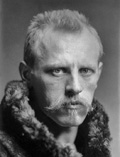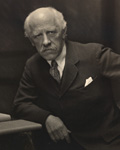
|
History of Geology |

Born: 10 Oct. 1861, Store Frøen near Christiania, now Oslo, Norway.
Died: 13 May 1930, Lysaker, near Oslo, Norway.
| Abstract | Introduction & Greenland |
| Arctic expedition | Nansen's later life |
| Historical assessment | Related websites |

|
History of Geology |

Born: 10 Oct. 1861, Store Frøen near Christiania, now Oslo, Norway.
Died: 13 May 1930, Lysaker, near Oslo, Norway.
| Abstract | Introduction & Greenland |
| Arctic expedition | Nansen's later life |
| Historical assessment | Related websites |
Nansen announced his plan to cross the Greenland Ice Sheet in 1887. He adapted Lapp ski and sled techniques as well as Inuit snowshoes and learned the Inuit language. Nansen, Otto Sverdrup and four companions completed the crossing from east to west in only a few weeks of late summer, 1888. They overwintered in Godthåb on the west coast and returned to Norway in May 1889. Nansen's crossing proved for the first time the existence of a continuous ice sheet in Greenland and, thus, gave support to Agassiz's still-controversial glacial theory.
Nansen's greatest expedition was crossing of the Arctic Ocean in a specially designed ship, the Fram. Nansen, Sverdrup, and a crew of 11 sailed from Norway in 1893. They followed a course along the northern coast of Siberia, and became frozen into the Arctic ice pack near the New Siberian Islands. In March 1895, Nansen and Frederik Johansen left the Fram and travelled over the ice in an attempt to reach the North Pole. They were able to reach 86°14' N latitude before turning back. They overwintered in Franz Josef Land during 1895-96. Nansen, Fram and crew were eventually reunited and returned to Christiania in 1896 to a hero's welcome. A 2-volume work on Fram over Polhavet was published in 1897, along with an English translation titled Farthest north. The journey was remarkable for Arctic exploration of the time; not a single casualty or major mishap took place.
Upon his return, Nansen was appointed Professor of zoology (later changed to oceanography) at Christiania University. He participated in many oceanographic voyages and developed scientific instruments. He also became quite active politically, first nationally and later internationally. He was an outstanding member of the League of Nations after World War I, and was awarded the Nobel Peace Prize in 1922 for his humanitarian work.
His first oceanic trip was on the Viking sealing ship to Greenland waters. There
he began to develop a plan for an expedition to cross the Greenland Ice Sheet. He announced
his plan in 1887 to cross Greenland from east to west. All previous expeditions had attempted
the crossing from west to east; all had failed miserably. Nansen adapted Lapp ski and sled
techniques, as well as Inuit snowshoes. He learned the Inuit language beforehand, as part
of his thorough preparation.
Nansen presented his proposal to the Norwegian Geographical Society in 1890 and to the Royal
Geographical Society (London) in 1892. The plan was severely criticized. However, the
Norwegian Parliament funded two-thirds of the cost; the remainder was paid by King Oscar II
plus private contributions. The total cost was 25,000 £. Fram (meaning "forward")
was an immensely strong, more than 400-ton ship built in Scotland. The design criteria included
three main points.
In March of 1895, Nansen and Frederik Johansen departed the Fram and attempted to reach
the North Pole. They took three dog sleds for crossing the ice and kayaks to traverse open water.
They actually reached 86°14' N latitude, the farthest north anyone had been at the time.
They turned back when their dogs began to give out and reached Franz Josef Land, where they
spent the winter, August 1895 to May 1896. They lived in a hut they made of stone with a roof
of walrus hides; they ate polar bear and walrus using the blubber as fuel.
Nansen and Johansen started to Svalbard the next summer and met Jackson's party from a British
expedition. They returned to Norway on the British ship Windward, reaching Vardø on August 13, 1896. Meanwhile, the Fram drifted as far north as 85°57' and eventually was released from the pack ice. Many scientific observations and experiments were
conducted. Nansen, Fram and crew were reunited finally and returned to Christiania on
September 9, 1896, once again to a hero's welcome.
A 2-volume work on Fram over Polhavet was published in 1897. The English translation, titled Farthest North, came out the same year. Nansen's success as an explorer was due to his careful evaluation of difficulties and risks, thorough planning, and meticulous attention to detail.
Nansen became deeply involved in the political movement for Norwegian independence from Sweden.
The Swedish-Norwegian union was dissolved peacefully in 1905. Nansen was appointed the first
Norwegian minister in London, 1906-08. In 1917 he headed a Norwegian commission to the United States, and he negotiated an agreement to import essential supplies to Norway during World War I.
Following World War I, the League of Nations was formed, and Nansen was appointed head
of the Norwegian delegation in 1920. He was the commissioner in charge of repatriation
from Russia of nearly half a million German and Austro-Hungarian prisoners of war. Russia refused to recognize the League, but
was willing to negotiate with Nansen. Most prisoners were returned. He was also the Red
Cross commissioner to deal with Russian refugees of famine. He raised funds privately and
created an identity card (Nansen card) for refugees. For his humanitarian efforts, Nansen
won the Nobel Peace Prize in 1922. He remained an outstanding member of the League of Nations until his death in 1930.
Nansen developed an entirely new approach to Arctic
exploration, one that was based on understanding and working within the environmental limits.
Previous expeditions had attempted to transfer temperate European techniques into a hostile
environment without success. Many men and ships were destroyed, lost, or killed by such
tactics. Nansen's expeditions, on the other hand, involved small crews and carefully conceived
methods based on Inuit and Lapp techniques of survival. In all of Nansen's exploits, not a
single person, major piece of equipment, or important scientific observation was lost. No
other person or exploration program, before or since, can claim such an outstanding record for
success and safety under such adverse conditions.
Return to history of geology syllabus or schedule.Introduction and Greenland
Nansen was a Norwegian explorer, oceanographer, statesman, and humanitarian. He was first
to cross the Greenland Ice Sheet and first to cross the Arctic Ocean. Nansen attended
school in Christiania (now Oslo) and took the entrance exam to the University of Christiania
(now Univ. of Oslo) in 1880. He studied zoology. He loved the outdoors, was an athlete and
an artist. In 1882, he was appointed curator of zoology at the Bergen Museum, and in 1887
he received the Ph.D. degree from the University of Christiania for a dissertation on the
central nervous system.

Portrait of Fridtjof Nansen in 1890 shortly after his return from Greenland. In the public domain; obtained from Wikimedia Commons. Arctic Expedition
In 1879-81, the United States expedition of DeLong and Bennet ventured into Siberian Arctic
waters. Their ship, the Jeannette, became frozen into ice and was destroyed near
Jeannette Island. Three years later, relicts of the Jeannette were found in southwestern
Greenland. The possibility of pack-ice drift across the Arctic Ocean was realized, and this
was the basis for Nansen's next great expedition to the north. He conceived a specially
built ship that would freeze into the ice pack near Alaska and drift across the Arctic to
Greenland or Svalbard.
This was the most remarkable set of criteria ever laid out for a voyage of exploration to
that time. In its day, it was analogous to space-shuttle missions of the late 20th century.
The resulting ship had a triple oak/greenwood hull, 24-28 inches (61-71 cm) thick. It could
proceed under steam or sail power.

The Fram Ship Museum, Oslo, Norway. Nansen's ship is on display in the A-framed building, along with other famous ships in the water. Photo © J.S. Aber.

Nansen's Fram on display in the Fram Ship Museum, Oslo, Norway.
This ship was used also by Roald Amundsen, who was first to reach the South Pole in 1911.
Photo © J.S. Aber.
Nansen's Later Life
Upon Nansen's return to Norway in 1896, he was appointed professor of zoology at Christiania
University. Later his title was changed to professor of oceanography in 1908. He conducted
much scientific work until 1917, including several oceanographic cruises and scientific
reports. Among his notable credits are improvements of instrument design (Nansen bottle),
explanation of wind-driven currents, and understanding Arctic waters.

Portrait of Fridtjof Nansen in 1922 upon receiving the Nobel Peace Prize. In the public domain; obtained from Wikimedia Commons. Historical Assessment
Nansen was clearly a person of many talents, abilities, and interests. His main contribution
in geology was in the field of glaciology. He proved the existence of the Greenland Ice Sheet,
thereby gaining general acceptance for the theory of glaciation that Agassiz had popularized
half a century before. To commemorate Nansen's achievement, a group of Norwegians conducted
a similar Greenland crossing in 1988 using the same kinds of equipment and techniques that
Nansen had used a century before (Hagen 1989). His other major scientific works were in the
field of oceanography, but he was not really a geologist. Related Websites
Related Websites
Reference

© J.S. Aber (2017).